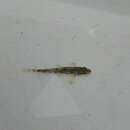en
names in breadcrumbs


Romanogobio benacensis és una espècie de peix de la família dels ciprínids i de l'ordre dels cipriniformes.
Romanogobio benacensis és una espècie de peix de la família dels ciprínids i de l'ordre dels cipriniformes.
Der Po-Gründling (Romanogobio benacensis) ist eine stark gefährdete Fischart aus der Familie der Karpfenfische. Die ursprünglich in Flüssen des nördlichen Italiens und Sloweniens verbreitete Art wird aus ihrem angestammten Lebensraum von einem eingeschleppten Verwandten, dem Gründling (Gobio gobio), verdrängt.[1]
Das Verbreitungsgebiet des Po-Gründlings war ursprünglich auf die Flussgebiete des Po in Norditalien sowie die des Isonzo und der Reka in Slowenien begrenzt. Er wurde allerdings auch nach Mittelitalien in die Flussgebiete von Arno und Ombrone eingeführt.[1][3] Die Spezies bewohnt neben den großen Hauptströmen auch Kanäle, warme Bäche und Teiche. Po-Gründlinge sind in der Regel auf sandigem Grund zu finden, meiden aber starke Strömungen.[2]
Bei einer Standardlänge von bis zu zehn Zentimetern und gattungstypischem Körperbau ist der Po-Gründling von seinen europäischen Verwandten äußerlich durch die Anzahl der Schuppen zwischen Afterflosse und Anus zu unterscheiden. Die Art verfügt hier nur über zwei bis drei Schuppen, während andere Vertreter der Gattung Romanogobio und auch der Gründling (G. gobio) in diesem Bereich vier bis acht Schuppen tragen.[2][1] Die Bauchschuppen reichen von der Basis der Brustflossen bis zu der der Bauchflossen.[2]
Der in kleinen Gruppen lebende Po-Gründling ernährt sich vorwiegend von kleinen Wirbellosen. Die Paarungszeit dauert von April bis Juni, abgelaicht wird in mehreren Portionen über Sandgrund. Sieben bis acht Tage nach der Eiablage schlüpfen die Larven. Der Nachwuchs pflanzt sich selbst im Alter von ein bis zwei Jahren zum ersten Mal fort. Po-Gründlinge erleben ein bis zwei Fortpflanzungsperioden und erreichen ein Alter von vier Jahren.[2]
Der Po-Gründling wurde 2007 von Kottelat und Freyhof aus der Gattung Gobio in die Gattung Romanogobio transferiert.[2] Bianco sieht diese Änderung nicht durch die Ergebnisse genetischer Untersuchungen gedeckt.[1]
Das angestammte Verbreitungsgebiet des Po-Gründlings ist zwar relativ groß, die verbliebenen Vorkommen beschränken sich jedoch auf verhältnismäßig wenige Stellen und die Population ist stark fragmentiert. Hauptursache ist vermutlich der zu Zwecken der Sportfischerei umfangreich eingeführte Gründling (G. gobio), der mit der einheimischen Art konkurriert und sie in ihrem Habitat ersetzt. Weitere Bedrohungen gehen von Gewässerverschmutzung und wasserbaulichen Maßnahmen aus. Die IUCN führt den Po-Gründling daher als „stark gefährdet“ (endangered).[1][3]
Po-Gründling auf Fishbase.org (englisch)
Der Po-Gründling (Romanogobio benacensis) ist eine stark gefährdete Fischart aus der Familie der Karpfenfische. Die ursprünglich in Flüssen des nördlichen Italiens und Sloweniens verbreitete Art wird aus ihrem angestammten Lebensraum von einem eingeschleppten Verwandten, dem Gründling (Gobio gobio), verdrängt.
Romanogobio benacensis is a species of ray-finned fish in the family Cyprinidae. It is found in Italy and Slovenia. Its natural habitat is rivers. It is threatened by habitat loss.
The Latin specific epithet benacensis refers to Lake Garda in northern Italy, which was known to the Romans as 'Benacus'.[2][3]
Romanogobio benacensis is a species of ray-finned fish in the family Cyprinidae. It is found in Italy and Slovenia. Its natural habitat is rivers. It is threatened by habitat loss.
The Latin specific epithet benacensis refers to Lake Garda in northern Italy, which was known to the Romans as 'Benacus'.
Gobio benacensis es una especie de peces de la familia de los Cyprinidae en el orden de los Cypriniformes.
Los machos pueden llegar alcanzar los 12 cm de longitud total.[1][2]
Es un pez de agua dulce.
Se encuentra en Italia.
Gobio benacensis es una especie de peces de la familia de los Cyprinidae en el orden de los Cypriniformes.
Romanogobio benacensis Romanogobio generoko animalia da. Arrainen barruko Actinopterygii klasean sailkatzen da, Cyprinidae familian.
Romanogobio benacensis Romanogobio generoko animalia da. Arrainen barruko Actinopterygii klasean sailkatzen da, Cyprinidae familian.
Romanogobio benacensis is een straalvinnige vissensoort uit de familie van de eigenlijke karpers (Cyprinidae).[1] De wetenschappelijke naam van de soort is voor het eerst geldig gepubliceerd in 1816 door Pollini.
Bronnen, noten en/of referenties
Romanogobio benacensis é uma espécie de peixe actinopterígeo da família Cyprinidae.
Pode ser encontrada nos seguintes países: Itália e Eslovénia.[2]
Os seus habitats naturais são: rios.[2]
Está ameaçada por perda de habitat.[2]
Romanogobio benacensis é uma espécie de peixe actinopterígeo da família Cyprinidae.
Pode ser encontrada nos seguintes países: Itália e Eslovénia.
Os seus habitats naturais são: rios.
Está ameaçada por perda de habitat.
Romanogobio benacensis là một loài cá vây tia thuộc họ Cyprinidae. Loài này có ở Ý và Slovenia.
Môi trường sống tự nhiên của chúng là sông ngòi. Chúng hiện đang bị đe dọa vì mất môi trường sống.
Romanogobio benacensis là một loài cá vây tia thuộc họ Cyprinidae. Loài này có ở Ý và Slovenia.
Môi trường sống tự nhiên của chúng là sông ngòi. Chúng hiện đang bị đe dọa vì mất môi trường sống.